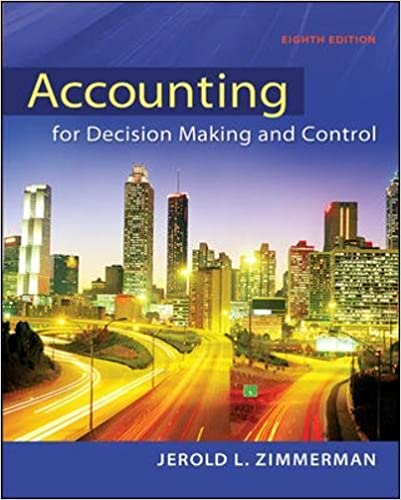
Accounting for Decision Making and Control 8th Edition by Jerold Zimmerman
Edition 8ISBN: 978-0078025747
Accounting for Decision Making and Control 8th Edition by Jerold Zimmerman
Edition 8ISBN: 978-0078025747 Exercise 16
Conner Coffees
The Breckenridge, Colorado, plant of Conner Coffees roasts, grinds, and packages premier coffees for upscale coffee cafes. The manager of the Breckenridge plant is evaluated and rewarded based on absorption costing net income of her plant. The Breckenridge plant sells its coffees in five-pound vacuum sealed foil packs for $60 per five-pound pack. Each pack has a variable manufacturing cost of $30. Annual total fixed manufacturing cost is $48,000. The Breckenridge plant expects to sell 10,000 packs this year and the manager can produce 10,000, 11,000, or 12,000 packs. Variable cost per pack of $30 will not change if the plant manager produces between 10,000 and 12,000 packs. Assume there are no beginning inventories, fixed and variable period costs are zero, and the corporate income tax rate is zero.
Required:
a. If the manager of the Breckenridge plant has the discretion to set the production level and seeks to maximize her bonus, what production level (10,000, 11,000, or 12,000) will be chosen and how much absorption costing net income will be reported?
b. Instead of evaluating the Breckenridge manager based on absorption costing net income, the Breckenridge manager is evaluated based on absorption costing residual income of her plant using a 12 percent weighted average cost of capital. What production level (10,000, 11,000, or 12,000) will the Breckenridge manager select and how much absorption costing residual income will be reported?
c. Critically analyze the statement: "The use of residual income solves the overproduction problem created by absorption costing." Under what conditions is this statement true and under what conditions is it false?
The Breckenridge, Colorado, plant of Conner Coffees roasts, grinds, and packages premier coffees for upscale coffee cafes. The manager of the Breckenridge plant is evaluated and rewarded based on absorption costing net income of her plant. The Breckenridge plant sells its coffees in five-pound vacuum sealed foil packs for $60 per five-pound pack. Each pack has a variable manufacturing cost of $30. Annual total fixed manufacturing cost is $48,000. The Breckenridge plant expects to sell 10,000 packs this year and the manager can produce 10,000, 11,000, or 12,000 packs. Variable cost per pack of $30 will not change if the plant manager produces between 10,000 and 12,000 packs. Assume there are no beginning inventories, fixed and variable period costs are zero, and the corporate income tax rate is zero.
Required:
a. If the manager of the Breckenridge plant has the discretion to set the production level and seeks to maximize her bonus, what production level (10,000, 11,000, or 12,000) will be chosen and how much absorption costing net income will be reported?
b. Instead of evaluating the Breckenridge manager based on absorption costing net income, the Breckenridge manager is evaluated based on absorption costing residual income of her plant using a 12 percent weighted average cost of capital. What production level (10,000, 11,000, or 12,000) will the Breckenridge manager select and how much absorption costing residual income will be reported?
c. Critically analyze the statement: "The use of residual income solves the overproduction problem created by absorption costing." Under what conditions is this statement true and under what conditions is it false?
Explanation
Absorption costing
Under absorption cos...
Accounting for Decision Making and Control 8th Edition by Jerold Zimmerman
Why don’t you like this exercise?
Other Minimum 8 character and maximum 255 character
Character 255


